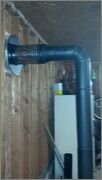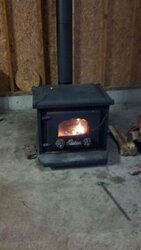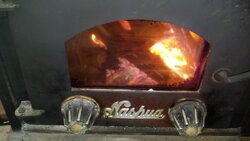Hey guys, first off i want to say thanks for the help along the way.
I got home from work today and fired up the Nashua stove like i usually do when it's cold. Today it was 50 and windy. I've burned the stove about 20 times this year without an issue, windy, cold, etc. Today was a different story....
I stacked my kindling and put a little fire starter in there and let it start going, when i looked at it about 5 minutes later i saw smoke rolling out the door and the knobs on the front, the fire was going. I opened the door and put some more kindling on to see if i could get a draw, still no go, smoke was rolling bad. I opened all the windows and doors to ventilate so that i could shovel out the coals and wood that had begun to burn. Once i got everything shoveled out into my metal bucket and outside i began to inspect the pipes. I pulled the chimney cap and everything look good, i pulled the T cap and look up the pipe and it's all good. I pulled the stove pipe off of the back of the stove and made sure that was clear all the way through the wall. Then i inspected the stove itself to make sure there were not obstructions. Everything looks good. I will note that on the outside of my building I only have 2 sections after the T. MY install goes up inside the building about 5-6ft, into an elbow, through the wall, and to a T where it then goes up 2 sections. As i mentioned I have never had an issue with draw before today.
Any ideas what could cause this? Do i need to run another vertical section outside in order to prevent this?
No matter what i did, i could not get the stove to draw and burn, it was just a smoking like a chimney, except not out the chimney!
I got home from work today and fired up the Nashua stove like i usually do when it's cold. Today it was 50 and windy. I've burned the stove about 20 times this year without an issue, windy, cold, etc. Today was a different story....
I stacked my kindling and put a little fire starter in there and let it start going, when i looked at it about 5 minutes later i saw smoke rolling out the door and the knobs on the front, the fire was going. I opened the door and put some more kindling on to see if i could get a draw, still no go, smoke was rolling bad. I opened all the windows and doors to ventilate so that i could shovel out the coals and wood that had begun to burn. Once i got everything shoveled out into my metal bucket and outside i began to inspect the pipes. I pulled the chimney cap and everything look good, i pulled the T cap and look up the pipe and it's all good. I pulled the stove pipe off of the back of the stove and made sure that was clear all the way through the wall. Then i inspected the stove itself to make sure there were not obstructions. Everything looks good. I will note that on the outside of my building I only have 2 sections after the T. MY install goes up inside the building about 5-6ft, into an elbow, through the wall, and to a T where it then goes up 2 sections. As i mentioned I have never had an issue with draw before today.
Any ideas what could cause this? Do i need to run another vertical section outside in order to prevent this?
No matter what i did, i could not get the stove to draw and burn, it was just a smoking like a chimney, except not out the chimney!
Last edited:




 ! LMAO
! LMAO
